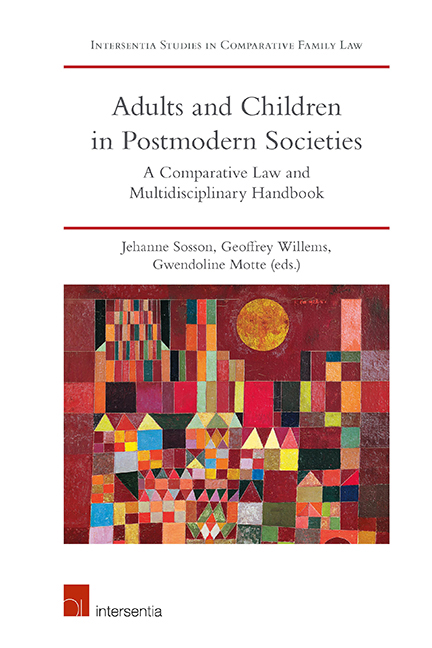Book contents
- Frontmatter
- Contents
- List of Cases
- List of Contributors
- Introduction
- PART I NATIONAL REPORTS ON LEGAL REGULATIONS OF RELATIONSHIPS BETWEEN ADULTS AND CHILDREN
- PART II INTERDISCIPLINARY APPROACH
- PART III INTERNATIONAL LAW INSIGHTS
- PART IV COMPARATIVE APPROACH
- Parentage, Parenthood and Parental Responsibility in Traditional Families
- Emergence and Development of Artificial Reproductive Technologies
- Multiplication of Potential Social and Emotional Ties
- The Future of Legal Relationships between Adults and Children: Complex Issues and Hybrid Solutions
- General Conclusion: The Challenge of Transparent and Inclusive Parenthood/Parentality in a Pluralist and Cosmopolitan Context
- About the Editors
Emergence and Development of Artificial Reproductive Technologies
from PART IV - COMPARATIVE APPROACH
Published online by Cambridge University Press: 26 June 2019
- Frontmatter
- Contents
- List of Cases
- List of Contributors
- Introduction
- PART I NATIONAL REPORTS ON LEGAL REGULATIONS OF RELATIONSHIPS BETWEEN ADULTS AND CHILDREN
- PART II INTERDISCIPLINARY APPROACH
- PART III INTERNATIONAL LAW INSIGHTS
- PART IV COMPARATIVE APPROACH
- Parentage, Parenthood and Parental Responsibility in Traditional Families
- Emergence and Development of Artificial Reproductive Technologies
- Multiplication of Potential Social and Emotional Ties
- The Future of Legal Relationships between Adults and Children: Complex Issues and Hybrid Solutions
- General Conclusion: The Challenge of Transparent and Inclusive Parenthood/Parentality in a Pluralist and Cosmopolitan Context
- About the Editors
Summary
INTRODUCTION
Over the last decades, the emergence and development of artificial reproductive technologies (ART) (artificial insemination, in vitro fertilisation and surrogacy) have facilitated the creation of new types of family configurations, bringing unprecedented challenges for family lawmakers. When contemplating contemporary relationships between adults and children, one has to consider children born thanks to reproductive medicine, and notably with the help of a third party (donor or surrogate), leading to dissociations of paternity and/or maternity. These situations have necessarily implied redefining parenthood in order to take into account intention, as the biological ground is missing for at least one of the adults who wanted the birth of the child.
This chapter proposes a comparative analysis on this issue of the 18 jurisdictions represented in this book and highlights how legal systems manage to solve the tension between biology and intention when recognising and protecting the relationship and the place of each adult surrounding the conception of a child by ART.
As the questions raised are obviously different, the presentation will treat separately artificial insemination and in vitro fertilisation on the one hand (section 1), and surrogacy on the other hand (section 2).
ARTIFICIAL INSEMINATION (AI) AND IN VITRO FERTILISATION (IVF)
Conceiving a child by artificial insemination (AI) or in vitro fertilisation (IVF) is possible using the gametes of the two intended parents (homologous AI or IVF), or with biological material of a third-party donor intervening in the procedure (heterologous AI or IVF).
This section will examine, in the 18 surveyed legal systems, the authorised techniques (section 1.1) and access conditions (section 1.2), and then analyse the recognition and protection of the relationship between the intended parents and the child (section 1.3) and of the place of the third-party donor (section 1.4).
AUTHORISED TECHNIQUES
First interesting pieces of data emerging from the comparative law overview are the authorised artificial techniques in the reviewed jurisdictions.
- Type
- Chapter
- Information
- Adults and Children in Postmodern SocietiesA Comparative Law and Multidisciplinary Handbook, pp. 759 - 792Publisher: IntersentiaPrint publication year: 2019



